When an offense has stood the test of time, there is a reason...IT WORKS! The Princeton Offense has been used for years to get easy backdoor lay ups and open shots! And it works especially well against aggressive man-man defenses.
There are many different pieces to the Princeton Offense. One piece of Aaron Jennings' Princeton Offensive System is the Chin Series.
The Chin Series has been implemented and used at all levels, from middle school to the NBA. The Chin Series is a continuity piece of the Princeton Offense. It is nearly impossible to stop when executed correctly.
While there are several parts to the Princeton Offense, Aaron Jennings breaks it down into easy individual pieces that can be implemented individually or as a part of the Princeton Offense in its entirety. Chin Series is one piece of the offense that is easy to implement and can be used at ANY level!
5 Reasons to Implement The Chin Offense
1. Easy to Implement
The Chin Offense is relatively easy to implement. While putting in the entire Princeton Offense can take some time to implement and teach the offense, putting in the Chin Piece of the offense is a quick way to get started and create easy shots for your team.
2. Creates Open Shots
Every Coach wants to put their team in the best position to score. The Chin Series does just that. It uses a team's aggressive defensive nature against them. By doing this, it gets your players easy backdoor layups that can be demoralizing for your opponent.
3. Keeps the Defense off Balance
As soon as you get a backdoor layup, defensive teams begin worrying about the backdoor cut.
This opens you up for a 3 pointer or a curl to the basket as your defender trails you.
4. Builds Confidence
Players have rules to follow when running Chin. They know where they should go on the court. When they are confident, they play at a faster speed on offense... and when you play at a faster speed, you are HARDER TO GUARD!
5. Narrows Your Focus
Like anybody, players do better when they can focus on less. The Chin Series allows your players to do just that ...focus on less and execute at a higher level. Instead of trying to make multiple reads at once, you are giving them one or two reads to make.
FREE BONUS PDF
33 Winning Basketball Plays
The Princeton Offense Starts With GREAT SPACING
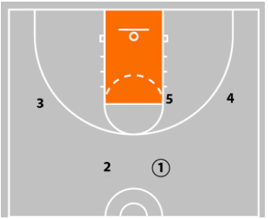
Do You Want An Easy Lay Up? Just Pass-Pass-Throw It
Aaron Jennings, who has played in the Princeton Offense while at Northwestern University and has used it as a coach for over a decade, states the first part of the Chin Series, Pass-Pass-Throw It, has scored more lay-ups than any other offense he has ever run.
Chin Series Part 1: Pass-Pass-Throw It
PASS-PASS-THROW IT
Pass-Pass-Throw is a quick ball movement set that will get you many lay ups when you run it. Making crisp, sharp passes is key.
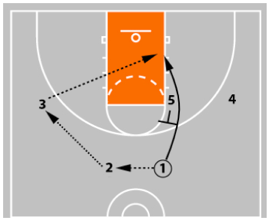
OPTION 1: Backdoor Lay Up
2. As soon as the PG passes the ball, they receive a back screen from the 5 and they may get a quick lay up off a pass from the wing.
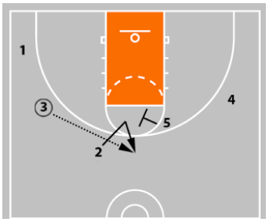
OPTION 2: Flare Screen
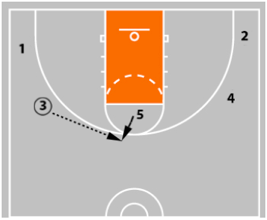
OR
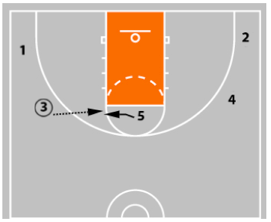
OPTION 3: Elbow Jumper
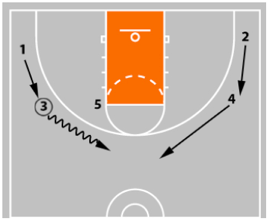
OPTION 4: Continuity
Chin Series Part 2: Strong
CHIN STRONG
When teams decide they must take the ball reversal away from you, then your team can turn to Chin Strong. Chin Strong gives you quick, easy scoring options that get everyone involved in the offense.
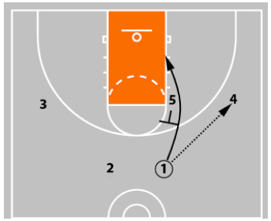
OPTION 1: UCLA Cut
2. The wing looks for a quick pass to the PG for a lay up as the first option
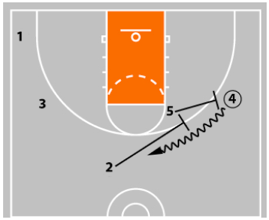
OPTION 2: Staggered Ball Screens
2. The 4-man tries to turn the corner and attack the basket.
3. The 5-man rolls to basket looking for bounce pass.
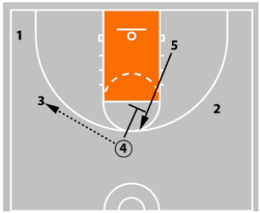
OPTION 3: Downscreen for Post
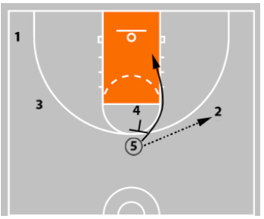
OPTION 4: 5-Man Diving
2. The 4-man sets a back screen for the 5-man to dive and look for a pass from the wing.
Chin Series Part 3: High Post
A third great option in the Chin Series is entering the ball to the high post. This creates scoring options that will keep the defense off balance!
This is one of the best parts of the offense. While Coach Jennings has used the offense to create uptempo, easy scoring opportunities for his team, each coach can put their unique fingerprint on this offense.
The 3 Parts Of The Princeton Offense
Chin Series is only one piece of this effective offense. The other two parts of Aaron Jennings' Princeton Offense are the Point Series and the Low Series.
Point Series - The Point Series is an offense that is initiated by entering the ball to a high post.
The Point Series emphasizes and teaches the split-action where the offense is reading what the defense is giving you and taking advantage of this. This split-action leads to many backdoor lay up opportunities as well as wide open 3s.
Low Series- The Low Series allows for teams to go seamlessly from transition into the Princeton Offense. It also utilizes low post play as an option, giving teams something different to worry about on defense while still focusing on multiple backdoor cuts.
The Low Series has something for everyone. It is a transition offense that looks to attack through low post first, but then multiple backdoor cuts looking to put extreme pressure on aggressive defenses...and once again, when they fear the backdoor cut, open 3s will flow naturally from this system.
What NBA Teams Know That You Don’t
Coach Pete Carril
One thing Coach Pete Carril is known for is winning 514 games over a 29 year career at Princeton. Maybe his most memorable moment was the 2011 shock of defeating the defending champion UCLA Bruins 43-41 in the NCAA tournament. A game that showed the entire world what the Princeton Offense could do. While Coach Carril has since retired, his offense lives on with basketball teams around the world.
This offense gave the more talented teams he faced headaches for years. Although Coach Carill will be the first to tell you he did not invent the backdoor cut, coaches will tell you that he learned to use it more effectively than ANY OTHER COACH IN HISTORY! Colleges across the country soon followed suit and implemented this highly effective offense.
Copycat Coaches
Coaches are known to "borrow" offenses that work when they see opportunities to improve their team. These coaches know one thing-if you are going to implement an offense, implement one that creates easy scoring opportunities for your team and gives your team the best chance to win.
It is hard to find an NBA team that has not adopted or used a variation of the Princeton Offense or principles. Just turn on the TV and watch the Sacramento Kings, New Jersey Nets, or Washington Wizards, each who have incorporated the Princeton Offense into their system. Coach John Beilein who successfully implemented parts of the Princeton Offense at Michigan will now bring those same principles to the Cleveland Cavaliers.
Many college teams have implemented all or pieces of the offense as well. You can find teams from coast to coast using the offense. One team is Coach Scott Mooney and the Richmond Spiders who have become a regular in NCAA Tournament use the Princeton Offense. Another team that has had success using the Princeton Offense is Coach Randy Bennett and the St. Mary's Gaels. Other teams have implemented principles taught in the offense into their system, such as the 2019 NCAA Champion Virginia Cavaliers under Coach Tony Bennett.
Implementation of the Princeton Offense
Implement Everything
Part of the beauty of Aaron Jennings' Princeton Offensive System is the fact that you can pick and choose what you want to implement. If you choose to implement the entire system, break it down by teaching one series at a time. Whether it is Chin, Point, or Low, wait until your team has a good understanding of the series you are implementing and then move on to the next piece of the Princeton Offense.
Each piece of the offense has several options. Break down the offense by looking at each option in the order it appears in the offense and then move on to the next option.
Implement A La Carte
Maybe you want to start with only one piece before implementing it all, you can easily do that. You can pick the piece of Aaron Jennings' Princeton Offense that best fits your teams, whether you have a team that everybody shoots the 3 well or you have 1 or 2 players that shoot well from the perimeter, the Princeton Offense has something for everyone.
Not Your Father's Princeton Offense
While the Princeton Offense has been around for years, Aaron Jennings' has made his system uptempo. The offense is ALWAYS looking to attack and in doing so it creates constant pressure on the Defense. Aaron Jennings' Princeton Offensive Systems looks to put up LOTS of points through:
The belief that the Princeton Offense is a slow down system has been thrown out the window. Today teams run the offense uptempo looking for quick, easy scoring opportunities.
Battle Tested
As a coach, you may not want to reinvent the wheel. You might prefer to select an offense that is battle tested. You will always make your "tweaks" to the offense as you go, but if you start with one that has had proven success over time, you give yourself a better chance to start with a solid offensive foundation.
Aaron Jennings' Princeton System is battle tested. Coach Jennings played in the Princeton System and has coached with it for over a decade. All together Coach Jennings has 15+ years of tweaking the offense. One tip for any coach is to make sure your quick hitters and counters that you run offensively, flow naturally as an extension of the offense.
Princeton Offense vs Zone
Ok, has this ever happened to you? You work on an offense and your players execute it so well the team has no other choice than to switch to zone against your team. It has happened to lots of coaches. One of the best ways to combat this is when players can easily identify when teams are in a zone defense and do not have to reset the offense to attack, but can naturally go into their zone offense, like the Princeton Offense allows teams to do.
Aaron Jennings' Princeton Offense has easy reads to identify when a team is in a zone. When your players see this, they seamlessly transition into the zone offense that Princeton flows into, without missing a beat.
You now took your opponent's desperation and have turned it into despair…..and will likely see them switch back to man-man defense since they did not fool you and you are getting the same easy looks in your zone offense.
Even better, many of the actions that work against man to man work against zone as well.
Chin is a staple of the Princeton offense. That said, it’s also effective against zones! There are two primary scoring options.

- The first is passing to the 5 after they set the back screen.
- The second is dribbling up from the wing, which lifts the bottom defender. This opens up the corner for the guard filling out.

- 1 passes to 2. As that pass happens, 5 comes up to the elbow.
- 2 immediately reverses the ball to 4.
- 5 back screens for 1. After the backscreen, 5 cuts to the ball side high post.

- 4 looks to 5 in the high post (or 1 at the rim).
- If x5 comes up, 5 looks to hit 1 behind the defense.
- If x5 stays low, 5 should shoot.

- If 5 is not open, 4 dribbles up.
- 4’s dribble cues 1 to fill the ballside corner and 5 to dive.
- 4 looks behind them to 1 in the corner. 1 can shoot is x4 has lifted. Or 1 can look to 5 at the rim.

- If nothing is open, 4 continues dribbling to the ballside slot.
- 2 bumps over
- 1 fills the wing.
- The offense is back in the original formation and can repeat the action on the other side.
Coaching Tips
- After setting the back screen, 5 must find the open spot in the zone when flashing to the ball side. This might be at the elbow. It might be a little lower.
- The guard coming off the back screen must get all the way to the rim. This positions them behind x5, creating uncertainty for that defender.
- If the ball hits the 5, the 3 players on the perimeter must shift to position themselves for a kick out pass. They don’t want to be 3 in a row (positioned directly behind a defender where a pass can’t be made).
3 Princeton Offense Basketball Plays
It is important to have quick hitters as part of your offensive system. This might be something you call from the bench or something you run coming out of a timeout. You want your quick hitters to be plays your team has high confidence in running.
In the Princeton System, some of these quick hitters use a team’s natural defensive aggressiveness against them. As you run quick hitters that make teams pay for being aggressive on defense and trying to “cheat” and take parts of the offense away, it will naturally allow the offense to open back up getting backdoor looks and 3’s. An example of an effective quick hitter would be Princeton’s Finger Wag from the Point Series.
Point Series- Finger Wag

- You want to enter the ball to the high post to start your offense (similar to Princeton Point Series). Teams start to deny this pass, so your PG and Post communicate the back door lob by the PG “wagging” his finger.
- This is an effective quick hitter because it flows naturally from the Point Series.
Chin Series - Chin: One
Chin action is really hard to guard. This play changes the nature of the screens from the traditional Chin action. That creates options the defense is not ready for. The play ends with a step up screen, which is not seen a lot at the middle and high school level.

- 1 passes to 2 as in the tradition Chin action.
- 2 reverses the ball to 3 and sprints through to the same side corner.
- 1 runs down the lane to the same side block.

- 4 curls off 5.
- If 4 is open, 3 should hit them for a layup.

- After screening for 4, 5 immediately turns and down screens for 1.
- Player 1 sprints to the top and catches a pass from 3.

- If 1 isn’t open to shoot, 5 sprints up and sets a step up ball screen.
- 1 looks to attack to the outside.
- 5 rolls.
- 4 flashes to the free throw line area.
Coaching Tips:
- In frame 1, 3 has the option to rip opposite on the catch and attack the rim to their left, since there is no baseline help.
- If 1 passes to 4 in the last frame, 5 should look to reverse pivot and seal for a hi-lo pass.
5’s should screen the back of x1 on the step up screen so that if they switch the defender is on the wrong side.
Chin Series: Chin: High Post
Chin: High Post is a great way to take advantage of a big who can pass. Defenses struggle when the ball is in the high post. It makes it hard for off ball defenders to maintain vision of the ball and their man. This play takes advantage of that with multiple scoring options.

- 1 passes to 5 and cuts to the basket.
- 5 will pass to 1 for a give and go layup if they’re open. If not, 1 clears to the opposite corner.

- Players 4 and 2 scissor off player 5.
- If 2 is open cutting off the back of 4, 5 should hand the ball off for a layup.
- 2 cuts to the rim before clearing to the ball side corner.

- Player 4 goes first and goes into a screen for player 3 on the opposite wing. 3 rejects the screen and looks for a backdoor layup.

- 5 pivots back at 2 for a two player game.
- 2 can cut backdoor if their defender overplays or take the handoff and attack the middle of the floor.
Princeton plays are ALWAYS going to be most effective when they are not easy to identify because they look like part of the offense.
Princeton Offense Sideline Out Of Bounds Play
One great thing about the Princeton Offense is that it is easy to flow into from out of bounds situations. This play disguises the Princeton action by starting in a box before flowing into Point series.

- 3 down screens for 1 and then exits to the corner
- 2 cuts to the ball side corner
- 4 passes to 1

- 5 flashes to the elbow
- 4 down screen for 2
- 1 passes to 5

- 5 dribbles at 2 for a hand off and tight roll
- At the same time, 3 down screens for 1
- 2 can attack, look at 1 coming off the screen, or 3 slipping after setting the screen
Princeton Continuity Basketball Offense
One unique aspect of the Princeton Offense is that you can run it as a continuity offense. That allows you to simplify some of the reads your players have to make while still taking advantage of all the options the Princeton provides.

- 1 dribbles at 2 and executes a dribble hand off.
- 3 & 4 interchange on the weak side.

- 2 reverses the ball and uses 5’s chin screen. 4 looks to 2 at the rim.
- 1 fills the spot vacated by 2 and 2 empties out to the same side wing.

- If 2 isn’t open, 4 dribbles at 3 for a dribble handoff.
- 5 sprints across the lane after the back screen.
- 1 & 2 interchange.

- 5 sprints into a screen and roll with player 3.
- Player 3 attacks the middle and reads the defense.
- 4 stays lift to make it harder for their defender to help on 5’s roll.

- If there’s no shot off the ball screen, the ball comes back to 2. 2 performs a dribble hand off with 1.
- 3 & 4 interchange.

- Players can now continue the pattern of the offense.
Additional Resources for the Princeton Offense
If you’d like to learn more about The Princeton Offensive System we recommend you take a look at Aaron Jennings Princeton Offensive System and eBook. Here you will learn step-by-step how to implement each piece of the Princeton Offense and help you effectively implement some or all of it with your team.
FREE BONUS PDF
33 Winning Basketball Plays
What do you think? Let us know by leaving your comments, suggestions, and questions...
|
||||||||||||||||||



 Facebook (145k Followers)
Facebook (145k Followers) YouTube (152k Subscribers)
YouTube (152k Subscribers) Twitter (33k Followers)
Twitter (33k Followers) Q&A Forum
Q&A Forum Podcasts
Podcasts